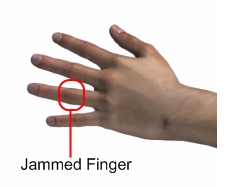

A finger bone can become broken in many ways, though it generally occurs after some type of trauma or accident.
Jammed finger xray crack#
Depending on the severity of the impact, a fractured finger could mean that it has a hairline crack or a completely shattered bone. When a finger is fractured, the bone has lost its integrity. So, how can you tell? If you’re unsure if your finger is broken, read below to find out which injury you may have. Sometimes, what appears to be a simple bruise can be a broken finger and vice versa. While fingers are easy to hurt, it can be difficult to diagnose the injury at home. So, whether it’s a sports injury or an accidental fall, injured fingers are common. We all use our hands for most daily activities and our fingers are relatively fragile. If you have a finger injury, schedule your appointment with an expert physician at Coastal Orthopedics, here. The risk does depend on the joint involved and the nature of the injury and you should discuss this with your surgeon where appropriate.Fingers are among the most easily injured body parts. In the long term a sprained joint may have a slight increased risk of developing osteoarthritis. Your Hand Surgeon and Therapist will discuss the options with you and an appropriate decision made. Under those circumstances your surgeon may suggest either the use of splints to support the joint or a repair or reconstruction of the damaged ligament. The symptoms are pain and weakness causing difficulty with use of the hand. This means the joint cannot resist the normal forces applied to it and will give way. The other slightly less common problem that can develop after a joint sprain, where a ligament has been damaged, is instability. If the joint does not respond then a surgical release may be needed. The therapists will undertake a programme of stretching, massage and exercises combined with the use of splints which can improve the situation.
Jammed finger xray full#
The loss of full straightening may be minor and not need any treatment, however if the finger is in a bent position that causes problems with use of the hand then additional treatment can be helpful. One of the recognised problems, after any sprain, is loss of movement which may be either a loss of bending or more commonly the straightening of the joint. Most patients, however, will regain a full range of movement. In particular the swelling around the joint may last several months. These injuries can take a suprisingly long time to heal. Surgical treatment is uncommon but may be required if one of the ligaments has been torn and if not repaired give rise to a risk that the joint may not fully recover and in particluar be unstable and unable to function satisfactorily. Your therapist will advise on these techniques. Other measures may include dynamic and static splints, ultrasound and massage. The swelling will reduce with time but can be helped by using compressive bandaging. Otherwise the joint will be encouraged to move straight away, this is done using specific exercises. In the initial phase the joint may be rested using a splint or cast if there is a lot of bruising and swelling. Your Hand Surgeon will advise you of the plan of treatment which will likely be instituted by a hand therapist. An x-ray will often show small fragments of bone which are attached to the damaged ligaments. The initial assessment will look at which structures have been damaged and decide on the appropriate method of treatment. The aim of the treatment is to restore movement to the injured joint. Further information on this injury can be found under Skiers thumb (also known as Game keepers thumb). The MP joint of the thumb is vulnerable to injury and one of the most frequently is the so called 'skiers thumb' where the ligament on the inside of the thumb is torn. The volar plate is damaged when force is applied in a longitudinal direction for example a ball hitting the end of the finger and the joint is forced into hyper-extension. This ligament prevents the joint from over straightening. The ligament that is injured most often is called the volar plate (palmar plate). The commonest joint to be sprained is the PIP joint. The amount of swelling usually reflects the degree of injury. In a minor sprain the tissues essentially remain intact and recover rapidly, in a more serious sprain the tissues may be badly torn and sometimes need to be repaired surgically.Īfter a sprain the injured joint will become swollen, painful and stiff. The capsule is less strong and acts to seal the joint from the other tissues. A sprain can be of varying degrees. The ligaments are strong structures that prevent a joint from going into an abnormal position. This includes the ligaments and joint capsule. A sprain refers to an injury to the tissues surrounding and supporting a joint.


 0 kommentar(er)
0 kommentar(er)
